 | –≠–ª–µ–∫—Ç—Ä–æ–Ω–Ω—ã–π –∫–æ–º–ø–æ–Ω–µ–Ω—Ç: MIC5021B | –°–∫–∞—á–∞—Ç—å:  PDF PDF  ZIP ZIP |
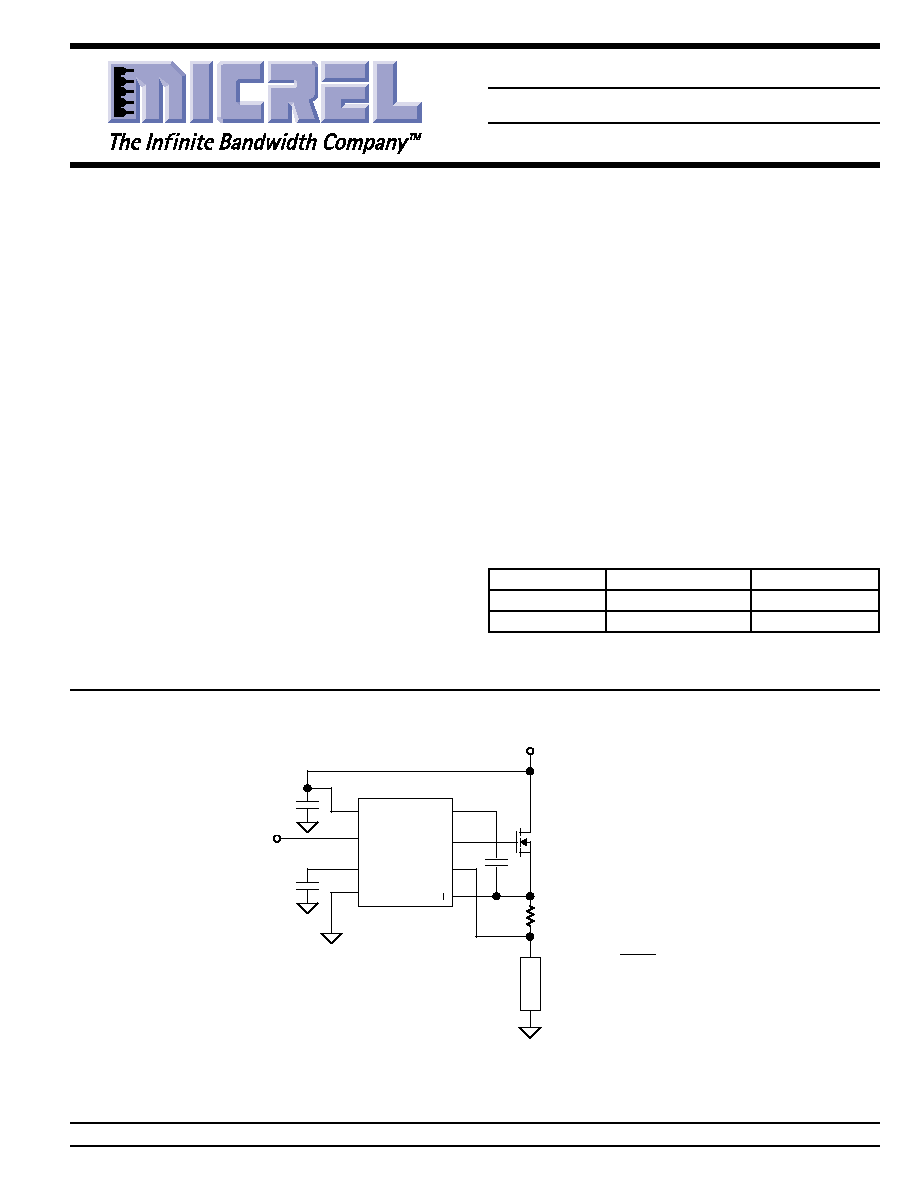
October 1998
1
MIC5021
MIC5021
Micrel
MIC5021
High-Speed High-Side MOSFET Driver
Final Information
Ordering Information
Part Number
Temperature Range
Package
MIC5021BM
≠40
∞
C to +85
∞
C
8-pin SOIC
MIC5021BN
≠40
∞
C to +85
∞
C
8-pin Plastic DIP
Features
∑ 12V to 36V operation
∑ 550ns rise/fall time driving 2000pF
∑ TTL compatible input with internal pull-down resistor
∑ Overcurrent limit
∑ Gate to source protection
∑ Internal charge pump
∑ 100kHz operation guaranteed over full temperature and
operating voltage range
∑ Compatible with current sensing MOSFETs
∑ Current source drive reduces EMI
Applications
∑ Lamp control
∑ Heater control
∑ Motor control
∑ Solenoid switching
∑ Switch-mode power supplies
∑ Circuit breaker
General Description
The MIC5021 high-side MOSFET driver is designed to oper-
ate at frequencies up to 100kHz (5kHz PWM for 2% to 100%
duty cycle) and is an ideal choice for high speed applications
such as motor control, SMPS (switch mode power supplies),
and applications using IGBTs. The MIC5021 can also
operate as a circuit breaker with or without automatic retry.
A rising or falling edge on the input results in a current source
pulse or sink pulse on the gate output. This output current
pulse can turn on a 2000pF MOSFET in approximately
550ns. The MIC5021 then supplies a limited current (< 2mA),
if necessary, to maintain the output state.
An overcurrent comparator with a trip voltage of 50mV makes
the MIC5021 ideal for use with a current sensing MOSFET.
An external low value resistor may be used instead of a
sensing MOSFET for more precise overcurrent control. An
optional external capacitor placed from the C
T
pin to ground
may be used to control the current shutdown duty cycle (dead
time) from 20% to < 1%. A duty cycle from 20% to about 75%
is possible with an optional pull-up resistor from C
T
to V
DD
.
The MIC5021 is available in 8-pin SOIC and plastic DIP
packages.
Other members of the MIC502x family include the MIC5020
low-side driver and the MIC5022 half-bridge driver with a
cross-conduction interlock.
Typical Application
V
DD
Input
C
T
Gnd
V
BOOST
Gate
Sense
Sense
TTL Input
R
SENSE
N-Channel
Power MOSFET
+12V to +36V
MIC5021
1
2
3
4
8
7
6
5
10µF
2.7
nF
Load
R
SENSE =
50mV
I
TRIP
* increases time before retry
optional*
High-Side Driver with Overcurrent Trip and Retry
Micrel, Inc. ∑ 1849 Fortune Drive ∑ San Jose, CA 95131 ∑ USA ∑ tel + 1 (408) 944-0800 ∑ fax + 1 (408) 944-0970 ∑ http://www.micrel.com
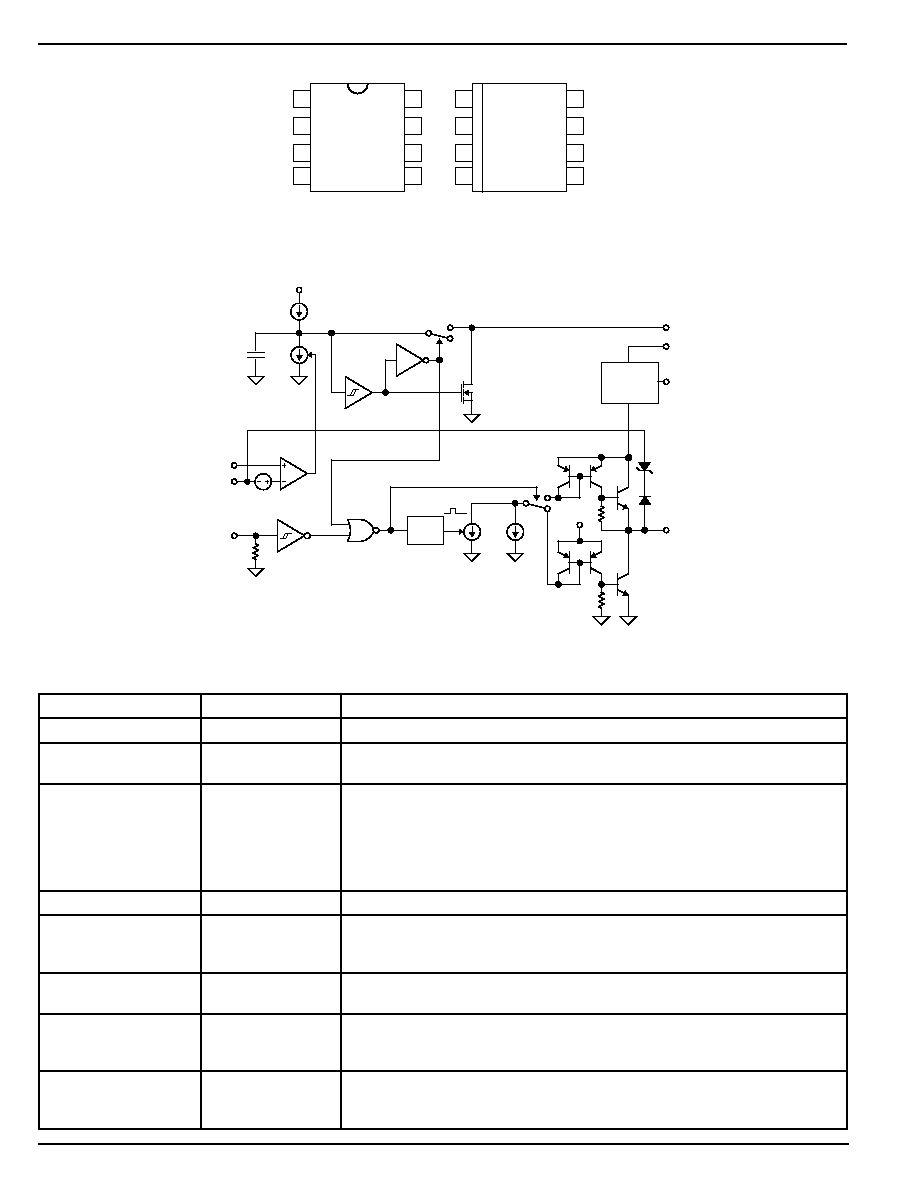
MIC5021
Micrel
MIC5021
2
October 1998
Pin Description
Pin Number
Pin Name
Pin Function
1
V
DD
Supply: +12V to +36V. Decouple with
10
µ
F capacitor.
2
Input
TTL Compatible Input: Logic high turns the external MOSFET on. An
internal pull-down returns an open pin to logic low.
3
C
T
Retry Timing Capacitor: Controls the off time (t
G(OFF)
) of the overcurrent
retry cycle. (Duty cycle adjustment.)
∑ Open = approx. 20% duty cycle.
∑ Capacitor to Ground = approx. 20% to < 1% duty cycle.
∑ Pull-up resistor = approx. 20% to approx. 75% duty cycle.
∑ Ground = maintained shutdown upon overcurrent condition.
4
Gnd
Circuit Ground
5
Sense +
Current Sense Comparator (+) Input: Connect to high side of sense resistor
or current sensing MOSFET sense lead. A built-in offset in conjunction with
R
SENSE
sets the load overcurrent trip point.
6
Sense ≠
Current Sense Comparator (≠) Input: Connect to the low side of the sense
resistor (usually the high side of the load).
7
Gate
Gate Drive: Drives the gate of an external power MOSFET. Also limits V
GS
to 15V max. to prevent Gate-to-Source damage. Will sink and source
current.
8
V
BOOST
Charge Pump Boost Capacitor: A bootstrap capacitor from V
BOOST
to the
FET source pin supplies charge to quickly enhance the Gate output during
turn-on.
Pin Configuration
1
2
3
4
8
7
6
5
V
DD
Input
C
T
Gnd
V
BOOST
Gate
Sense
-
Sense
+
1
2
3
4
8
7
6
5
V
BOOST
Gate
Sense
-
Sense
+
V
DD
Input
C
T
Gnd
Block Diagram
Sense ≠
Sense +
6V Internal Regulator
C
INT
I
1
2I
1
50mV
Input
ONE-
SHOT
Gate
C
T
6V
OFF
ON
Fault
Normal
I
2
10I
2
15V
Q1
CHARGE
PUMP
V
DD
V
BOOST
Transistor: 106
DIP Package
SOIC Package
(N)
(M)

October 1998
3
MIC5021
MIC5021
Micrel
Electrical Characteristics
T
A
= 25
∞
C, Gnd = 0V, V
DD
= 12V, C
T
= Open, Gate C
L
= 1500pF (IRF540 MOSFET) unless otherwise specified
Symbol
Parameter
Condition
Min
Typ
Max
Units
D.C. Supply Current
V
DD
= 12V, Input = 0V
1.8
4
mA
V
DD
= 36V, Input = 0V
2.5
6
mA
V
DD
= 12V, Input = 5V
1.7
4
mA
V
DD
= 36V, Input = 5V
2.5
6
mA
Input Threshold
0.8
1.4
2.0
V
Input Hysteresis
0.1
V
Input Pull-Down Current
Input = 5V
10
20
40
µ
A
Current Limit Threshold
Note 1
30
50
70
mV
Gate On Voltage
V
DD
= 12V Note 2
16
18
21
V
V
DD
= 36V Note 2
46
50
52
V
t
G(ON)
Gate On Time, Fixed
Sense Differential > 70mV
2
6
10
µ
s
t
G(OFF)
Gate Off Time, Adjustable
Sense Differential > 70mV, C
T
= 0pF
10
20
50
µ
s
t
DLH
Gate Turn-On Delay
Note 3
500
1000
ns
t
R
Gate Rise Time
Note 4
400
500
ns
t
DLH
Gate Turn-Off Delay
Note 5
800
1500
ns
t
F
Gate Fall Time
Note 6
400
500
ns
f
max
Maximum Operating Frequency
Note 7
100
150
kHz
Note 1
When using sense MOSFETs, it is recommended that R
SENSE
< 50
. Higher values may affect the sense MOSFET's current transfer ratio.
Note 2
DC measurement.
Note 3
Input switched from 0.8V (TTL low) to 2.0V (TTL high), time for Gate transition from 0V to 2V.
Note 4
Input switched from 0.8V (TTL low) to 2.0V (TTL high), time for Gate transition from 2V to 17V.
Note 5
Input switched from 2.0V (TTL high) to 0.8V (TTL low), time for Gate transition from 20V (Gate on voltage) to 17V.
Note 6
Input switched from 2.0V (TTL high) to 0.8V (TTL low), time for Gate transition from 17V to 2V.
Note 7
Frequency where gate on voltage reduces to 17V with 50% input duty cycle.
Absolute Maximum Ratings
Supply Voltage (V
DD
) .................................................. +40V
Input Voltage ................................................ ≠0.5V to +15V
Sense Differential Voltage ..........................................
±
6.5V
Sense + or Sense ≠ to Gnd .......................... ≠0.5V to +36V
Timer Voltage (C
T
) ..................................................... +5.5V
V
BOOST
Capacitor .................................................... 0.01
µ
F
Operating Ratings
Supply Voltage (V
DD
) .................................... +12V to +36V
Temperature Range
PDIP ....................................................... ≠40
∞
C to +85
∞
C
SOIC ...................................................... ≠40
∞
C to +85
∞
C

MIC5021
Micrel
MIC5021
4
October 1998
0.0
0.5
1.0
1.5
2.0
2.5
5
10
15
20
25
30
35
40
I
SUPPLY
(mA)
V
SUPPLY
(V)
Supply Current vs.
Supply Voltage
V
IN
= 0V
V
IN
= 5V
650
700
750
800
850
900
5
10
15
20
25
30
35
40
t
ON 4V
(ns)
V
SUPPLY
(V)
Gate Turn-On Delay vs.
Supply Voltage
V
GATE
= V
SUPPLY
+ 4V
C
L
= 1500pF (IRCZ34)
C
BOOST
= 0.01
µ
F
INCLUDES PROPAGATION DELAY
750
800
850
900
950
1000
5
10
15
20
25
30
35
40
t
ON 10V
(ns)
V
SUPPLY
(V)
Gate Turn-On Delay vs.
Supply Voltage
V
GATE
= V
SUPPLY
+ 10V
C
L
= 1500pF (IRCZ34)
C
BOOST
= 0.01
µ
F
INCLUDES PROPAGATION DELAY
0.0
0.5
1.0
1.5
2.0
2.5
1x10
0
1x10
1
1x10
2
1x10
3
1x10
4
1x10
5
t
ON
(
µ
s)
C
GATE
(pF)
Gate Turn-On Delay vs.
Gate Capacitance
V
GATE
= V
SUPPLY
+ 4V
V
SUPPLY
= 12V
INCLUDES PROPAGATION DELAY
750
1000
1250
1500
1750
2000
5
10
15
20
25
30
35
40
t
OFF 4V
(ns)
V
SUPPLY
(V)
Gate Turn-Off Delay vs.
Supply Voltage
V
GATE
= V
SUPPLY
+ 4V
R
L
= 400
INCLUDES PROPAGATION DELAY
C
GATE
= 1500pF
(IRCZ34)
0
5
10
15
20
25
0.1
1
10
100
1000 10000
RETRY DUTY CYCLE (%)
C
T
(pF)
NOTE:
t
ON
, t
OFF
TIME
INDEPENDENT
OF V
SUPPLY
Overcurrent Retry Duty
Cycle vs. Timing Capacitance
t
ON
= 5
µ
s
V
SUPPLY
= 12V
0
5
10
15
20
25
5
10
15
20
25
30
35
40
V
GATE
(V)
V
SUPPLY
(V)
Gate Voltage Change
vs. Supply Voltage
V
GATE
= V
GATE
≠ V
SUPPLY
0
20
40
60
80
100
0
5
10
15
20
25
I
IN
(
µ
A)
V
IN
(V)
Input Current vs.
Input Voltage
V
SUPPLY
= 12V
Typical Characteristics
Timing Diagram 2. Fault Condition, C
T
= Open
Timing Diagram 3. Fault Condition, C
T
= Grounded
Input
0V
TTL (H)
Source
50mV
Sense +, ≠
Differential
Gate
0V
15V (max.)
6µs
20µs
Input
0V
TTL (H)
Source
50mV
Sense +, ≠
Differential
Gate
0V
15V (max.)
6µs
Input
0V
TTL (H)
Source
50mV
Sense +, ≠
Differential
Gate
0V
15V (max.)
Timing Diagram 1. Normal Operation
20
30
40
50
60
70
80
-60 -30
0
30
60
90 120 150
VOLTAGE (mV)
TEMPERATURE (
∞
C)
Sense Threshold vs.
Temperature

October 1998
5
MIC5021
MIC5021
Micrel
Functional Description
Refer to the MIC5021 block diagram.
Input
A signal greater than 1.4V (nominal) applied to the MIC5021
INPUT
causes gate enhancement on an external MOSFET
turning the MOSFET on.
An internal pull-down resistor insures that an open
INPUT
remains low, keeping the external MOSFET turned off.
Gate Output
Rapid rise and fall times on the
GATE
output are possible
because each input state change triggers a one-shot which
activates a high-value current sink (10I
2
) for a short time. This
draws a high current though a current mirror circuit causing
the output transistors to quickly charge or discharge the
external MOSFET's gate.
A second current sink continuously draws the lower value of
current used to maintain the gate voltage for the selected
state.
An internal charge pump utilizes an external "boost" capacitor
connected between V
BOOST
and the source of the external
MOSFET. (Refer to typical application.) The boost capacitor
stores charge when the MOSFET is off. As the MOSFET
turns on, its source to ground voltage increases and is added
to the voltage across the capacitor, raising the V
BOOST
pin
voltage. The boost capacitor charge is directed through the
GATE
pin to quickly charge the MOSFET's gate to 16V
maximum above V
DD
. The internal charge pump maintains
the gate voltage.
An internal zener diode protects the external MOSFET by
limiting the gate to source voltage.
Sense Inputs
The MIC5021's 50mV (nominal) trip voltage is created by
internal current sources that force approximately 5
µ
A out of
SENSE
+ and approximately 15
µ
A (at trip) out of
SENSE
≠.
When
SENSE
≠ is 50mV or more below
SENSE
+,
SENSE
≠
steals base current from an internal drive transistor shutting
off the external MOSFET.
Overcurrent Limiting
Current source I
1
charges C
INT
upon power up. An optional
external capacitor connected to C
T
is kept discharged through
a MOSFET Q1.
A fault condition (> 50mV from
SENSE
+ to
SENSE
≠) causes
the overcurrent comparator to enable current sink 2I
1
which
overcomes current source I
1
to discharge C
INT
in a short time.
When C
INT
is discharged, the
INPUT
is disabled, which turns
off the gate output, and C
INT
and C
T
are ready to be charged.
When the gate output turns the MOSFET off, the overcurrent
signal is removed from the sense inputs which deactivates
current sink 2I
1
. This allows C
INT
and the optional capacitor
connected to C
T
to recharge. A Schmitt trigger delays the
retry while the capacitor(s) recharge. Retry delay is in-
creased by connecting a capacitor to C
T
(optional).
The retry cycle will continue until the fault is removed or the
input is changed to TTL low.
If C
T
is connected to ground, the circuit will not retry upon a
fault condition.
Supply Voltage
The MIC5021's supply input (V
DD
) is rated up to 36V. The
supply voltage must be equal to or greater than the voltage
applied to the drain of the external N-channel MOSFET.
A 16V minimum supply is recommended to produce continu-
ous on-state, gate drive voltage for standard MOSFETs (10V
nominal gate enhancement).
When the driver is powered from a 12V to 16V supply, a logic-
level MOSFET is recommended (5V nominal gate enhance-
ment).
PWM operation may produce satisfactory gate enhancement
at lower supply voltages. This occurs when fast switching
repetition makes the boost capacitor a more significant
voltage supply than the internal charge pump.
Applications Information
The MIC5021 MOSFET driver is intended for high-side
switching applications where overcurrent limiting and high
speed are required. The MIC5021 can control MOSFETs that
switch voltages up to 36V.
High-Side Switch Circuit Advantages
High-side switching allows more of the load related compo-
nents and wiring to remain near ground potential when
compared to low-side switching. This reduces the chances
of short-to-ground accidents or failures.
Speed Advantage
The MIC5021 is about two orders of magnitude faster than
the low cost MIC5014 making it suitable for high-frequency
high-efficiency circuit operation in PWM (pulse width modu-
lation) designs used for motor control, SMPS (switch mode
power supply) and heating element control.
Switched loads (on/off) benefit from the MIC5021's fast
switching times by allowing use of MOSFETs with smaller
safe operating areas. (Larger MOSFETs are often required
when using slower drivers.)

MIC5021
Micrel
MIC5021
6
October 1998
Logic-Level MOSFET Precautions
Logic-level MOSFETs have lower maximum gate-to-source
voltage ratings (typically
±
10V) than standard MOSFETs
(typically
±
20V). When an external MOSFET is turned on, the
doubling effect of the boost capacitor can cause the gate-to-
source voltage to momentarily exceed 10V. Internal zener
diodes clamp this voltage to 16V maximum which is too high
for logic-level MOSFETs. To protect logic-level MOSFETs,
connect a zener diode (5V
V
Zener
<10V) from gate to source.
Overcurrent Limiting
A 50mV comparator is provided for current sensing. The low
level trip point minimizes I
2
R losses when a power resistor is
used for current sensing.
The adjustable retry feature can be used to handle loads with
high initial currents, such as lamps or heating elements, and
can be adjusted from the C
T
connection.
C
T
to ground maintains gate drive shutdown following an
overcurrent condition.
C
T
open, or a capacitor to ground, causes automatic retry.
The default duty cycle (C
T
open) is approximately 20%. Refer
to the electrical characteristics when selecting a capacitor for
reduced duty cycle.
C
T
through a pull-up resistor to V
DD
increases the duty cycle.
Increasing the duty cycle increases the power dissipation in
the load and MOSFET under a "fault" condition. Circuits may
become unstable at a duty cycle of about 75% or higher,
depending on conditions.
Caution: The MIC5021 may be
damaged if the voltage applied to C
T
exceeds the absolute
maximum voltage rating.
Boost Capacitor Selection
The boost capacitor value will vary depending on the supply
voltage range.
V
DD
Input
C
T
Gnd
V
BOOST
Gate
Sense
Sense
TTL Input
+12V to +20V
MIC5021
1
2
3
4
8
7
6
5
10µF
0.01
µF
Load
Figure 1. 12V to 20V Configuration
A 0.01
µ
F boost capacitor is recommended for best perfor-
mance in the 12V to 20V range. Refer to figure 1. Larger
capacitors may damage the MIC5021.
V
DD
Input
C
T
Gnd
V
BOOST
Gate
Sense
Sense
TTL Input
+12V to +36V
MIC5021
1
2
3
4
8
7
6
5
10µF
2.7
nF
Load
Figure 2. 12V to 36V Configuration
If the full 12V to 36V voltage range is required, the boost
capacitor value must be reduced to 2.7nF. Refer to Figure 2.
The recommended configuration for the 20V to 36V range is
to place the capacitor is placed between V
DD
and V
BOOST
as
shown in Figure 3.
V
DD
Input
C
T
Gnd
V
BOOST
Gate
Sense
Sense
TTL Input
+12V to +36V
MIC5021
1
2
3
4
8
7
6
5
10µF
Load
0.1
µF
Figure 3. Preferred 20V to 36V Configuration
Do not use both boost capacitor between V
BOOST
and the
MOSFET source and V
BOOST
and V
DD
at the same time.
Current Sense Resistors
Lead length can be significant when using low value (< 1
)
resistors for current sensing. Errors caused by lead length
can be avoided by using four-teminal current sensing resis-
tors. Four-terminal resistors are available from several
manufacturers.
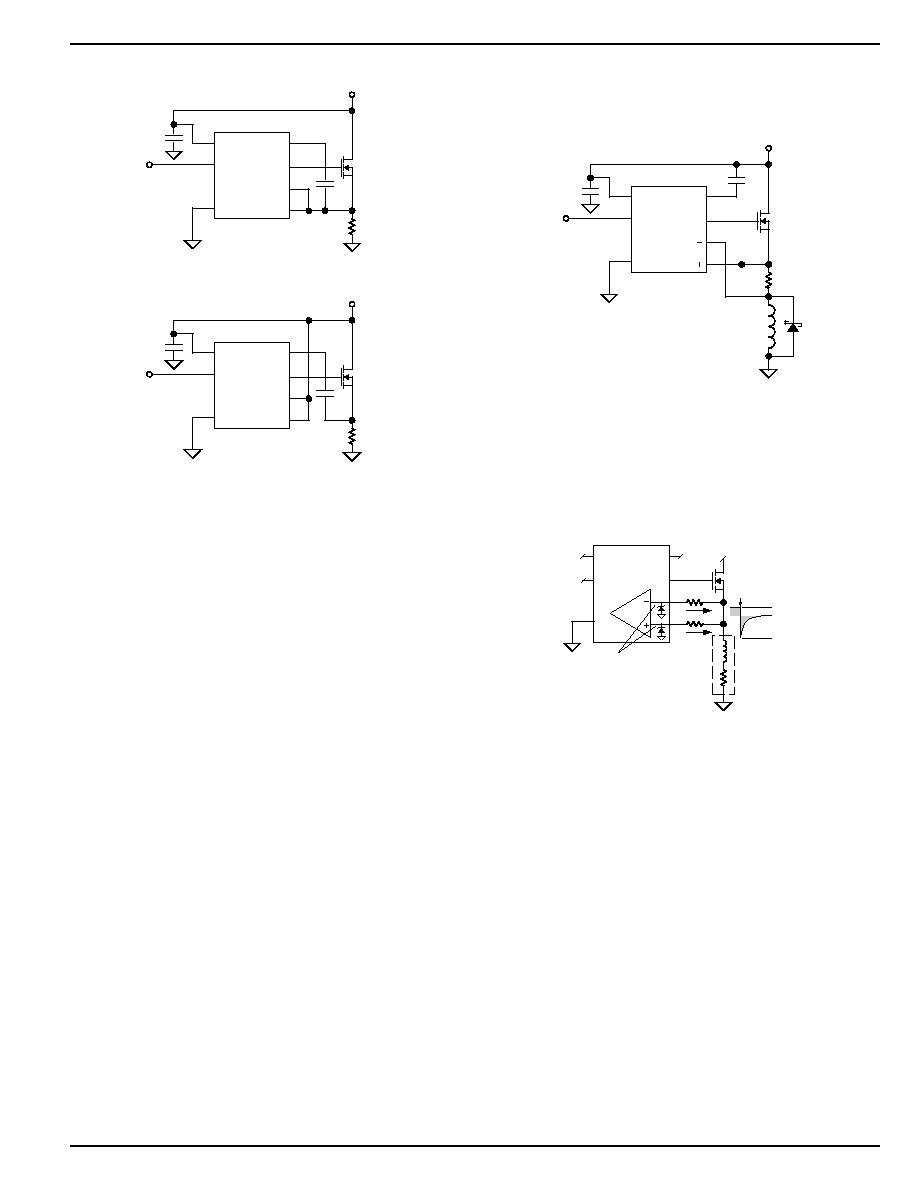
October 1998
7
MIC5021
MIC5021
Micrel
The diode should have a peak forward current rating greater
than the load current. This is because the current through the
diode is the same as the load current at the instant the
MOSFET is turned off.
V
DD
Input
C
T
Gnd
V
BOOST
Gate
Sense
Sense
TTL Input
R
SENSE
N-Channel
Power MOSFET
(IRF540)
+20V to +36V
MIC5021
1
2
3
4
8
7
6
5
10µF
Solenoid
(24V, 47
)
0.01
µF
Schottky
Diode
(1N5822)
(+24V)
(< 0.08
)
Figure 5. Solenoid Driver
with Current Sensing
Sense Pin Considerations
The sense pins of the MIC5021 are sensitive to negative
voltages. Forcing the sense pins much below ≠0.5V effec-
tively reverses the supply voltage on portions of the driver
resulting in unpredictable operation or damage.
MOSFET
Turnoff
0V
Negative
Spike
~V
DD
V
DD
Input
C
T
Gate
MIC5021
1
2
3
4
8
7
6
5
Inductive
Load
Current flows from ground (0V)
through the diodes to the load
during negative transcients.
Forward drop across diodes
allows leads to go negative.
Figure 6. Inductive Load Turnoff
Figure 6 shows current flowing out of the sense leads of an
MIC5021 during a negative transient (inductive kick). Internal
Schottky diodes attempt to limit the negative transient by
maintaining a low forward drop.
Although the internal Schottky diodes can protect the driver
in low-current resistive applications, they are inadequate for
inductive loads or the lead inductance in high-current resis-
tive loads. Because of their small size, the diodes' forward
voltage drop quickly exceeds 0.5V as current increases.
Circuits Without Current Sensing
V
DD
Input
C
T
Gnd
V
BOOST
Gate
Sense
-
Sense
+
TTL Input
Load
N-Channel
Power MOSFET
V+
MIC5021
1
2
3
4
8
7
6
5
10µF
0.01
µF
Figure 4a. Connecting Sense to Source
V
DD
Input
C
T
Gnd
V
BOOST
Gate
Sense
-
Sense
+
TTL Input
Load
N-Channel
Power MOSFET
V+
MIC5021
1
2
3
4
8
7
6
5
10µF
0.01
µF
Figure 4b. Connecting Sense to Supply
Current sensing may be omitted by connecting the
SENSE
+
and
SENSE
≠ pins to the source of the MOSFET or to the
supply. Connecting the
SENSE
pins to the supply is preferred
for inductive loads. Do not connect the
SENSE
pins to ground.
Inductive Load Precautions
Circuits controlling inductive loads, such as solenoids (Figure
5) and motors, require precautions when controlled by the
MIC5021. Wire wound resistors, which are sometimes used
to simulate other loads, can also show significant inductive
properties.
An inductive load releases stored energy when its current
flow is interrupted (when the MOSFET is switched off). The
voltage across the inductor reverses and the inductor at-
tempts to force current flow. Since the circuit appears open
(the MOSFET appears as a very high resistance) a very large
negative voltage occurs across the inductor.
Limiting Inductive Spikes
The voltage across the inductor can be limited by connecting
a Schottky diode across the load. The diode is forward biased
only when the load is switched off. The Schottky diode
clamps negative transients to a few volts. This protects the
MOSFET from drain-to-source breakdown and prevents the
transient from damaging the charge pump by way of the boost
capacitor. Also see
Sense Pin Considerations below.
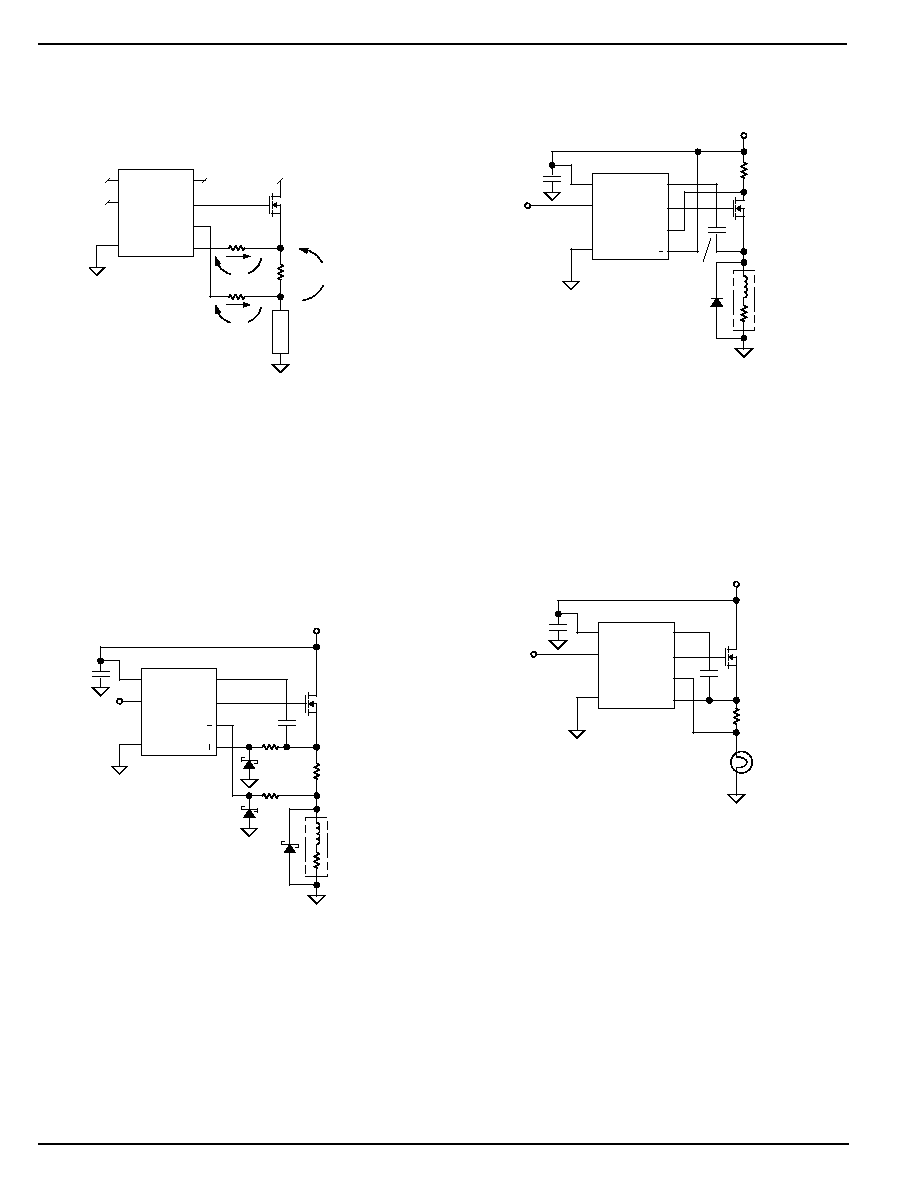
MIC5021
Micrel
MIC5021
8
October 1998
External Protection
Resistors placed in series with each
SENSE
connection limit
the current drawn from the internal Schottky diodes during a
negative transient. This minimizes the forward drop across
the diodes.
V
DD
Input
C
T
Gnd
V
BOOST
Gate
Sense
-
Sense
+
N-Channel
Power MOSFET
MIC5021
1
2
3
4
8
7
6
5
R
S
Load
5µA
15µA
V
R2
R1
R2
V
R1
= V
R2
to avoid skewing
the 50mV trip point.
.
(5mV suggested)
R1
3
◊
R2
V
R1
50mV nominal
(at trip)
Figure 7. Resistor Voltage Drop
During normal operation, sensing current from the sense pins
is unequal (5
µ
A and 15
µ
A). The internal Schottky diodes are
reverse biased and have no effect. To avoid skewing the trip
voltage, the current limiting resistors must drop equal volt-
ages at the trip point currents. See Figure 7. To minimize
resistor tolerance error, use a voltage drop lower than the trip
voltage of 50mV. 5mV is suggested.
External Schottky diodes are also recommended. See D2
and D3 in Figure 8. The external diodes clamp negative
transients better than the internal diodes because their larger
size minimizes the forward voltage drop at higher currents.
V
DD
Input
C
T
Gnd
V
BOOST
Gate
Sense
Sense
TTL Input
Inductive
Load
N-Channel
Power MOSFET
+12V to +36V
MIC5021
1
2
3
4
8
7
6
5
10µF
2.7
nF
R
SENSE
1.0k
330
R2
D2
11DQ03
D3
11DQ03
D1
R1
Figure 8. Protection from Inductive Kick
High-Side Sensing
Sensing the current on the high side of the MOSFET isolates
the
SENSE
pins from the inductive spike.
V
DD
Input
C
T
Gnd
V
BOOST
Gate
Sense
Sense
TTL Input
Wirewound
Resistor
(3
)
N-Channel
Power MOSFET
(IRFZ44)
+12V to +20V
R
SENSE
(< 0.01
)
(+12V)
MIC5021
1
2
3
4
8
7
6
5
10µF
0.01
µF
Figure 9. High Side Sensing
Lamp Driver Application
Incandescent lamps have a high inrush current (low resis-
tance) when turned on. The MIC5021 can perform a "soft
start" by pulsing the MOSFET (overcurrent condition) until
the filament is warm and its current decreases (resistance
increases). The sense resistor value is selected so the
voltage drop across the sense resistor decreases below the
sense threshold (50mV) as the filament becomes warm. The
FET is no longer pulsed and the lamp turns completely on.
V
DD
Input
C
T
Gnd
V
BOOST
Gate
Sense
-
Sense
+
TTL Input
R
SENSE
(0.041
)
N-Channel
Power MOSFET
(IRF540)
V+
MIC5021
1
2
3
4
8
7
6
5
10µF
0.01
µF
Incandescent
Lamp (#1157)
(+12V)
"( )" values apply to demo circuit.
See text.
Figure 10. Lamp Driver with
Current Sensing
A lamp may not fully turn on if the filament does not heat up
adequately. Changing the duty cycle, sense resistor, or both
to match the filament characteristics can correct the problem.
Soft start can be demonstrated using a #1157 dual filament
automotive lamp. The value of R
S
shown in Figure 10 allows
for soft start of the higher-resistance filament (measures
approx. 2.1
cold or 21
hot).
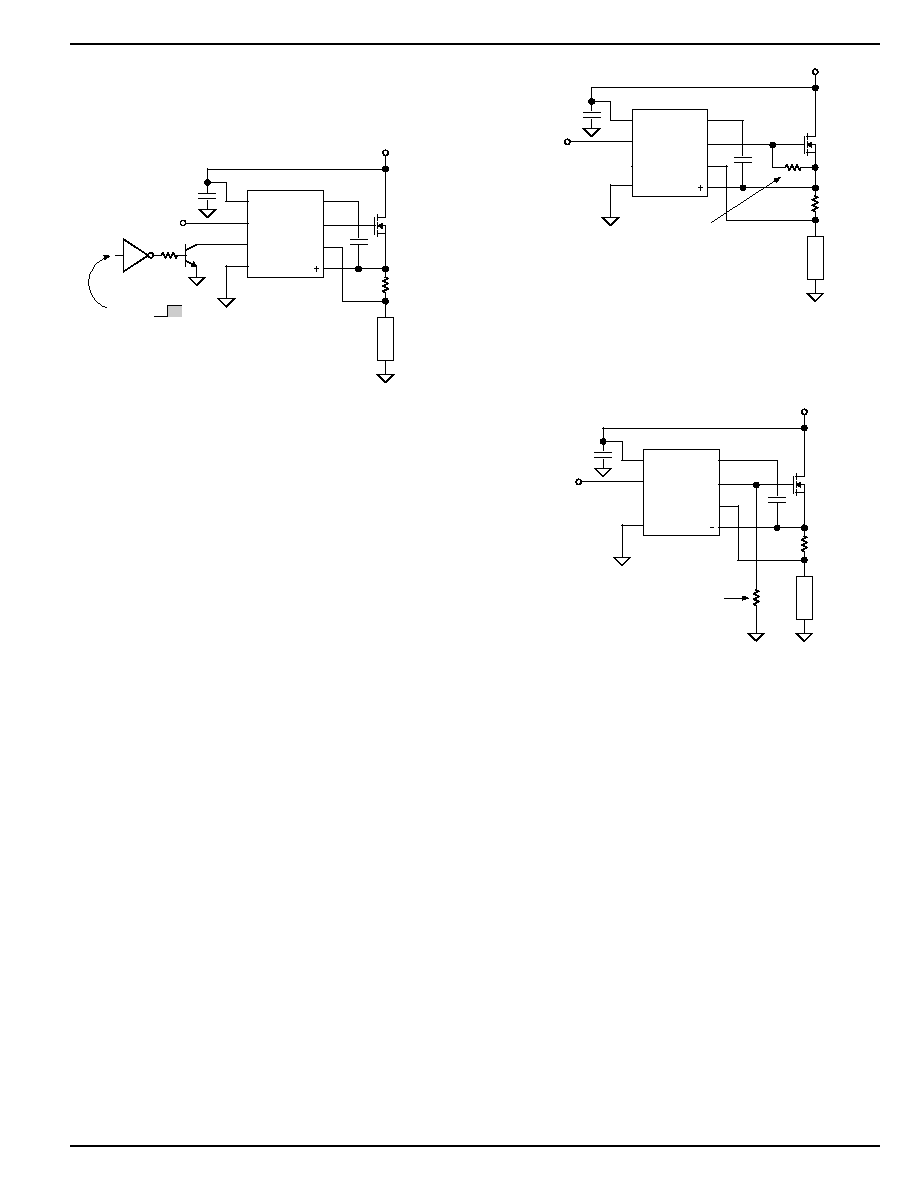
October 1998
9
MIC5021
MIC5021
Micrel
Remote Overcurrent Limiting Reset
In circuit breaker applications where the MIC5021 maintains
an off condition after an overcurrent condition is sensed, the
C
T
pin can be used to reset the MIC5021.
V
DD
Input
C
T
Gnd
V
BOOST
Gate
Sense
Sense
TTL Input
R
SENSE
N-Channel
Power
MOSFET
+12V to +20V
MIC5021
1
2
3
4
8
7
6
5
10µF
0.01
µF
Load
74HC04
(example)
2N3904
Q1
10k to
100k
Retry (H)
Maintained (L)
Figure 11. Remote Control Circuit
Switching Q1 on pulls C
T
low which keeps the MIC5021
GATE
output off when an overcurrent is sensed. Switching Q1 off
causes C
T
to appear open. The MIC5021 retries in about
20
µ
s and continues to retry until the overcurrent condition is
removed.
For demonstration purposes, a 680
load resistor and 3
sense resistor will produce an overcurrent condition when the
load's supply (V+) is approximately 12V or greater.
Low-Temperature Operation
As the temperature of the MIC5021AJB (extended tempera-
ture range version--no longer available) approaches ≠55
∞
C,
the driver's off-state, gate-output offset from ground in-
creases. If the operating environment of the MIC5021AJB
includes low temperatures (≠40
∞
C to ≠55
∞
C), add an external
2.2M
resistor as shown in Figures 12a or 12b. This assures
that the driver's gate-to-source voltage is far below the
external MOSFET's gate threshold voltage, forcing the
MOSFET fully off.
V
DD
Input
C
T
Gnd
V
BOOST
Gate
Sense
Sense
TTL Input
R
SENSE
+12V to +36V
MIC5021AJB
1
2
3
4
8
7
6
5
10µF
2.7
nF
Load
2.2M
add resistor for
≠40
∞
C to ≠55
∞
C
operation
Figure 12a. Gate-to-Source Pull Down
The gate-to-source configuration (refer to Figure 12a) is
appropriate for resistive and inductive loads. This also
causes the smallest decrease in gate output voltage.
V
DD
Input
C
T
Gnd
V
BOOST
Gate
Sense
Sense
TTL Input
R
SENSE
+12V to +36V
MIC5021AJB
1
2
3
4
8
7
6
5
10µF
2.7
nF
Load
2.2M
add resistor for
≠40
∞
C to ≠55
∞
C
operation
Figure 12b. Gate-to-Ground Pull Down
The gate-to-ground configuration (refer to Figure 12b) is
appropriate for resistive, inductive, or capacitive loads. This
configuration will decrease the gate output voltage slightly
more than the circuit shown in Figure 12a.

MIC5021
Micrel
MIC5021
10
October 1998
Package Information
0.380 (9.65)
0.370 (9.40)
0.135 (3.43)
0.125 (3.18)
PIN 1
DIMENSIONS:
INCH (MM)
0.018 (0.57)
0.100 (2.54)
0.013 (0.330)
0.010 (0.254)
0.300 (7.62)
0.255 (6.48)
0.245 (6.22)
0.380 (9.65)
0.320 (8.13)
0.0375 (0.952)
0.130 (3.30)
8-Pin Plastic DIP (N)
45
∞
0
∞
≠8
∞
0.244 (6.20)
0.228 (5.79)
0.197 (5.0)
0.189 (4.8)
SEATING
PLANE
0.026 (0.65)
MAX
)
0.010 (0.25)
0.007 (0.18)
0.064 (1.63)
0.045 (1.14)
0.0098 (0.249)
0.0040 (0.102)
0.020 (0.51)
0.013 (0.33)
0.157 (3.99)
0.150 (3.81)
0.050 (1.27)
TYP
PIN 1
DIMENSIONS:
INCHES (MM)
0.050 (1.27)
0.016 (0.40)
8-Pin SOP (M)

October 1998
11
MIC5021
MIC5021
Micrel

MIC5021
Micrel
MIC5021
12
October 1998
MICREL INC.
1849 FORTUNE DRIVE
SAN JOSE, CA 95131
USA
TEL
+ 1 (408) 944-0800
FAX
+ 1 (408) 944-0970
WEB
http://www.micrel.com
This information is believed to be accurate and reliable, however no responsibility is assumed by Micrel for its use nor for any infringement of patents or
other rights of third parties resulting from its use. No license is granted by implication or otherwise under any patent or patent right of Micrel Inc.
© 1998 Micrel Incorporated











